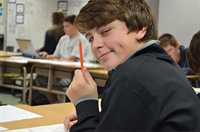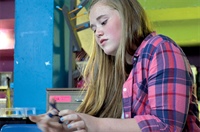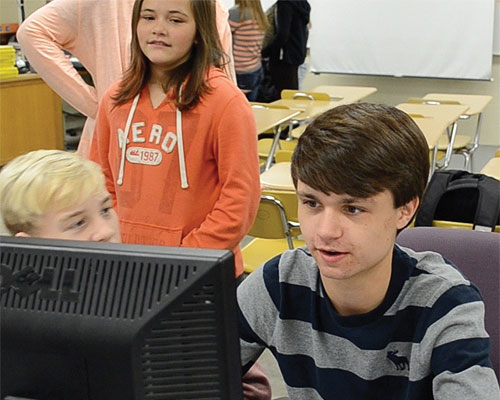The transition to or from middle school can be smooth for some, but those of us who serve in a middle school know just how stressful these moves can be for a large percentage of our students.
Students worry about their new teachers, whether they’ll be in classes with any of their friends, if they’ll be able to find the bathroom, who they’ll sit with at lunch, how they’ll get their combination lock opened in enough time to collect their materials and get to class on time…
These worries may seem trivial to some adults, but the anxiety can be an enormous burdon for middle school students to carry. In addition to changes in the learning environment, students in the middle—making the transition from elementary to middle school or from middle school to high school—also are grappling with physical and emotional changes.
So how do we get middle school students to let go of the fears that often accompany transitions to and from middle school? How do we get them over their concerns with social status and “fitting in” and the self-consciousness often associated with early adolescence so they can work toward becoming productive, responsible citizens? How do we get them to buy into academic content?
Perhaps most important, how do we inspire them to believe in themselves and work together to achieve a common goal?
The faculty members at Vance Middle School in Bristol, Tennessee, believe the answer is project-based and problem-based learning. With help from the $2,000 AMLE Foundation Collaborative Mini-Grant, and drawing on the expertise of the district high school’s graphic arts department led by Dereck Shipley, middle school students in Annie Edwards’ digital media classes embarked on a journey to create and publish our school yearbook in-house. The project is called From Picturing to Publishing.
In addition to addressing state standards in an authentic learning environment, partnering with high school students and teachers provides middle school students with the opportunity to draw on the knowledge and experience of others and establishes positive relationships that will help ease their next transition.
Finding Meaning

Collaborative projects such as From Picturing to Publishing help build student self-confidence.
To be successful, projects such as From Picturing to Publishing must be personally meaningful to students. In our case, rising costs makes buying the yearbook unaffordable for many of our students. Encouraging our digital media students to own the development of the yearbook gives them the opportunity to give back to the school through service-oriented, project-based learning. Our students work with our district’s high school students to create the publication start to finish, so we are able to drive the cost down, making the yearbooks more accessible to our entire student body.
Students are gaining real-world experience using state-of-the-art equipment, including the DSLR cameras purchased with AMLE grant funds, along with graphic design software that allows students to practice photo editing and document layout.
Annie Edwards shares, “Students need to know that what they are learning is applicable to their future education as well as the career path that they choose. This program is one that stresses the importance of retaining previously acquired knowledge and emphasizes the use of soft skills that are vital to the success of our seventh and eighth graders now and in the future.”
Easing Them In

Hands-on projects keep student engagement and enthusiastic about learning.
Problem-based/project-based learning affords our students, teachers, and administrators the opportunity to work together as a team to address real-world problems that affect school and community stakeholders while addressing the social, emotional, and academic needs of our middle school students. When we add collaboration with high school students and teachers, we get the additional advantage of knowing our middle school students are better prepared and eager to enter high school.
Vance Middle School Principal Amy Scott notes, “Each spring, we have the opportunity to bring sixth grade students from each of the district’s elementary schools to Vance for several days to allow them to become familiar with their teachers, new routines, and the physical layout of the building; however, scheduling doesn’t allow us to do the same for our exiting eighth graders. We now have a unique opportunity to grow our high school transition program through integrative collaborative projects completed through our related arts departments.”
Through From Picturing to Publishing, students with diverse academic and social backgrounds have come together to take charge of their own learning, and they are developing oral and written communication skills, including industry specific terminology, that will allow them to be successful now and in the future. Instead of being nervous about their upcoming transition to high school, they’re asking “When do we get to go back?”
Priceless Results
Although projects such as From Picturing to Publishing take careful planning and collaboration among teachers and students, the results are priceless! A few of the benefits we’ve already seen include:
- Middle school students are actively engaged in the learning process. They are eager to come to school and excited about learning to use technology that professional photographers and graphic designers use in the field. Students who participate in this project demonstrate a high degree of self-confidence along with the ability to think critically, make decisions, collaborate, and easily communicate with others.
- Assessment is authentic and mimics real-world, on-the-job expectations of producing an actual product for distribution—in this case, the middle school yearbook. Although we are starting small this year, taking group pictures and candid shots supplemented with video overlays using augmented reality apps to supplement our current yearbook, our goal for next year is to produce a complete school yearbook—cover to cover—including student-created portrait pages and book binding. “We’re excited about the 21st-century learning skills students at the middle and high school levels are honing as they communicate and collaborate to design and create the school yearbook,” Edwards says.
- Transitioning to high school will be easier for middle school students because they have had the opportunity to become acquainted with the physical layout of the building and develop relationships with upperclassmen and faculty during their visits to the high school graphics arts department. To further ease the transition to high school, our district’s graphic design teacher has committed to continue the project for the upcoming school year.
- Passion-driven, energetic teachers eager to work with students to develop meaningful projects that establish connections between high school and middle school students (or elementary and middle school students) are the key to easing transitions for students entering and exiting middle school. Whether coming or going, these projects lead to stronger relationships and a supportive learning and working environment for all involved.
Is it easy? Absolutely not, but as Dave Burgess, author of Teach Like a Pirate shared at AMLE2014: “It doesn’t have to be easy, it has to be worth it!” And worth it, it is!
Vonda Beavers, a former elementary teacher and middle school library media specialist, is the curriculum, testing, and data coordinator at Vance Middle School in Bristol, Tennessee.
![]() beaversv@btcs.org
beaversv@btcs.org
Published in AMLE Magazine, April 2015.
